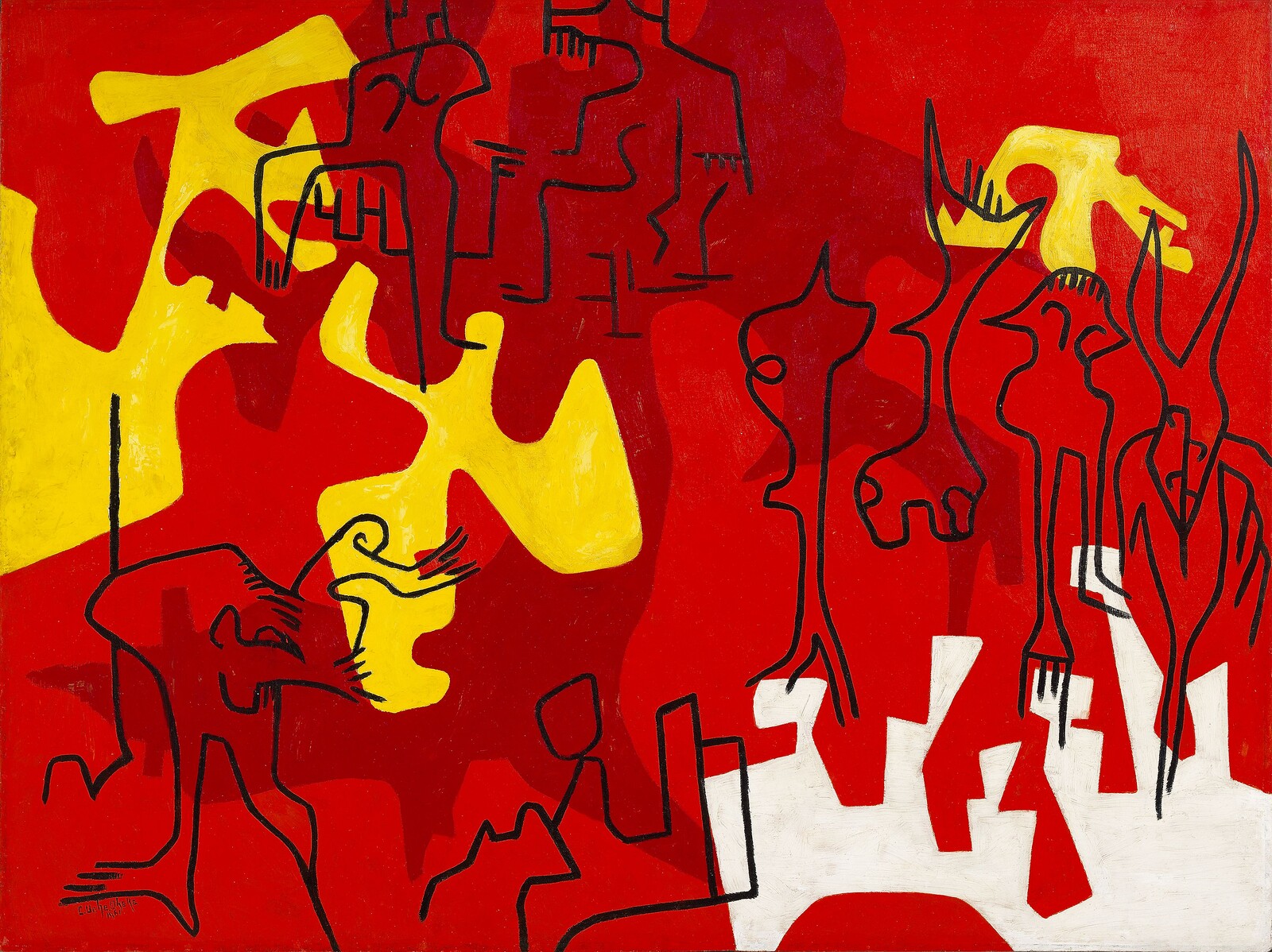March 10–August 6, 2023
1 Brookings Dr
St. Louis, MO 63130
USA
Hours: Wednesday–Monday 11am–5pm
T +1 314 935 4523
kemperartmuseum@wustl.edu
Organized by the American Federation of Arts and the Fisk University Galleries, African Modernism in America is the first major traveling exhibition to examine the complex connections between African artists and American patrons, artists, and cultural organizations amid the interlocking histories of civil rights, decolonization, and the Cold War. During these years, such institutions as the Museum of Modern Art, New York (MoMA), and Historically Black Colleges and Universities collected and exhibited works by many of the most important African artists of the mid-twentieth century, including Ben Enwonwu (Nigeria), Gerard Sekoto (South Africa), Ibrahim El-Salahi (Sudan), and Skunder Boghossian (Ethiopia). The inventive and irrefutably contemporary nature of these artists’ paintings, sculptures, and works on paper defy typical Western narratives about African art being isolated to a “primitive past”; their presentation in the US rooted these vital works firmly in the present for American audiences. This exhibition draws primarily from Fisk University’s remarkable collection of gifts from the Harmon Foundation, a leading American organization devoted to the support and promotion of African and African American artists and to forging links between transatlantic artists and audiences. It features more than seventy artworks by fifty artists that exemplify the relationships between the new art that emerged in Africa during the 1950s and 1960s and the art and cultural politics of the US.
In 1961 the Harmon Foundation organized the landmark exhibition Art from Africa of Our Time. The same year the Museum of Modern Art exhibited its first acquisition of contemporary African art, Men Taking Banana Beer to Bride by Night (1956) by Sam Ntiro (Tanzania). The simultaneity of the Harmon Foundation’s exhibition and MoMA’s purchase was crucially important in drawing attention to African artists’ modernity in a moment of shifting relationships between the US and African nations. By then many African nations had gained independence from colonial rule. That same year the Freedom Riders protested segregation in the American South, Congolese independence leader Patrice Lumumba was killed in a CIA-supported assassination plot, and eminent Pan-Africanist W.E.B. Du Bois emigrated to Ghana. Within the changing social and political contexts of colonialism, decolonization, and independence in Africa, artists developed new visual languages, and such exhibitions as Art from Africa of Our Time enabled US audiences to recognize their shared aesthetic and political concerns.
African Modernism in America is presented in four sections. The first, “Art from Africa of Our Time,” foregrounds the places and people who supported the Harmon Foundation exhibition and promoted modern African artists in the United States. The second section, “Modernism within Africa,” highlights the continent-wide networks of artists, galleries, literary journals, and art education programs instrumental in the development of these new, forward-thinking venues for the display and discussion of postcolonial art. The third section of the exhibition, “Modernism between Africa and America,” highlights the establishment of meaningful connections between African and African American artists in the US. The exhibition concludes with “The Politics of Selection,” a new commission by the Nigeria-based sculptor Ndidi Dike that interrogates the collecting histories in the Cold War as presented throughout the exhibition, including those of the Harmon Foundation. Dike’s immersive, multimedia installation examines the multiplicity of viewpoints, biases, prejudices, allegiances, and omissions she uncovered in her research in the archives at the Harmon Foundation and Fisk University.
Accompanying the exhibition are an illustrated timeline that highlights key cultural and political events in Africa and the United States and a curated playlist of African and African American music of the 1950s and ’60s.
This exhibition is organized by the American Federation of Arts and Fisk University Galleries. It is curated by Perrin Lathrop, Nikoo Paydar, and Jamaal Sheats.
Major support for the exhibition is provided by Monique Schoen Warshaw. Additional support is provided by grants from the Marlene and Spencer Hays Foundation, the Mellon Foundation, and the Andy Warhol Foundation for the Visual Arts. This project is supported in part by the National Endowment for the Arts.
The presentation at the Mildred Lane Kemper Art Museum was made possible by the leadership support of the William T. Kemper Foundation. All exhibitions at the Kemper Art Museum are supported by members of the Director’s Circle, with major annual support provided by Emily and Teddy Greenspan and additional generous annual support from Michael Forman and Jennifer Rice, Julie Kemper Foyer, Joanne Gold and Andrew Stern, Ron and Pamela Mass, and Kim and Bruce Olson. Further support is provided by the Hortense Lewin Art Fund, the Ken and Nancy Kranzberg Fund, and members of the Mildred Lane Kemper Art Museum.







